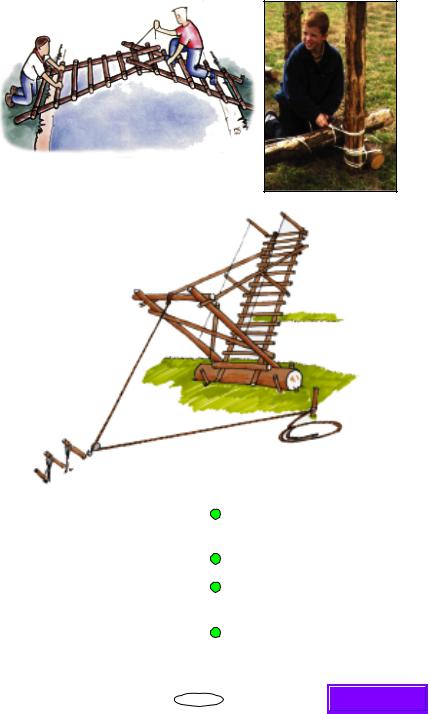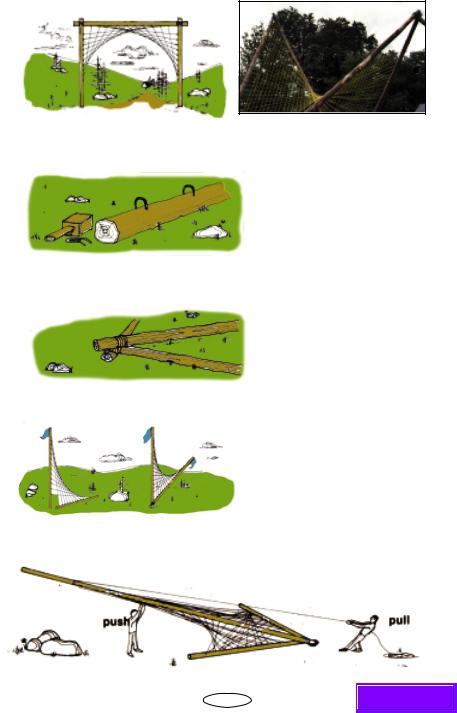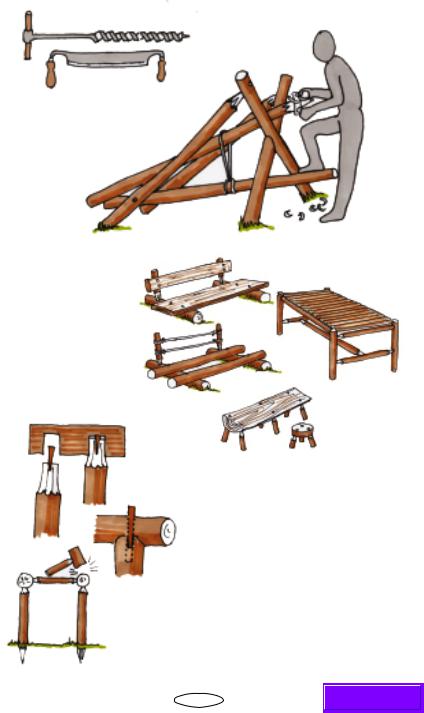
ScoutEngineering
.pdf
Draw bridge
The draw bridge is similar in construction to the trestle bridge. You need a trestle frame, a ladder structure - drawbridgesome tackle and picket anchor and a large log.
Equipment required
2 No. 6 metre spars
6 No. 4 metre spars
1 No. 3 metre spar
1 No. 2.5 metre spar Small poles for ladder A large log
Pickets
Pulley and 50mm rope Lashing ropes
How to build
Construct the trestle frame, bottom brace position will be determined by height of log.
Make a ladder structure using 6 metre spars and small poles as rungs.
Fix 4 metre braces from trestle frame to ladder and fix handrails. the handrails can be of rope or spars if you prefer. Place 3-2-1 picket anchor in the ground and rig up a pulley to it.
21 |
Main page |

Other challenges
Outback Bridge
SCOUT ENGINEERING
Friction bridge
No lashings are used in its construction you rely rather on the friction and tension of each log in the bridge to hold the structure together
Square tower
22

See-saw Bridge
Handrail detail
Stilt Tower
Abington spring bridge
Simple ‘A frame design’ Bridge
23 |
Main page |

Levering and lifting
Did you ever wonder how ancient peoples such as the Egyptians and the Druids managed to move large stones to form the pyramids or Newgrange - the used levers. This tried and proven
SCOUT ENGINEERING
method of shifting heavy loads should be used by your Patrol but to conserve energy and prevent injury.
When levers are being used for moving logs, or prising out boulders, care must be taken that the lever is strong enough to withstand the strain that is being placed on it. If you are using a lever to lift and object, lift it only a small distance at a time and place a roller or solid block under the object as you lift it. This will enable you to reposition the level after each lift. Work as a team to complete these type of tasks as accidents can happen if lifting is not undertaken with care.
Lift large poles using a team of people and use guy ropes to control the lift. It maybe necessary to construct an A frame to aid lifting.
24

Bamboo and elastic bands
Simple and elaborate structures can be built using bamboo canes and elastic bands. The secret is to construct small pyramid shapes which are strong and stable. These pyramids are then locked together to make more complex structures. It is important however that you maintain the pyramid shape in your design as it adds stability to the final project. It may also be necessary to peg down the structure to the ground in case of windy conditions.
25 |
Main page |

SCOUT ENGINEERING
Rope weave
There are few pioneering projects which can be described as ‘aesthetically beautiful’. The rope weave structure has very little value and the finished product is eye-catching, graceful and looks far more complicated than it really is.
Siting
The transparent nature of the rope weave means that it will blend in with any countryside and would not look out of place on top of a hill.
Digging
Guy lines of any sort will ruin the effect of any rope weave project which means that any upright poles must be dug firmly into the ground.
26

Staples
You will need strong wire staples to complete the rope weave. There should be the same number of staples on each spar. The distance between the staples is normally 100mm - 150mm apart however it is possible to vary the distance on both spars to create new effects - so experiment!
Stringing up
The poles should be loosely strung up on the ground, using a continuous length of string or coloured bailing twine, which can be tightened once the poles are firmly in place.
Erection
Erecting the structure is best done using sheer legs and temporary guys until the spars are firmly in the gound.
Tightening
Tightening will probably need to be done several times, depending on the weather. A ‘saggy’ weave does not look well.
27 |
Main page |

Peg and dowel
SCOUT ENGINEERING
Peg and dowel is a traditional technique used by craftspersons in the creation of rustic and tradition furniture and fencing. The technique involves the paring of poles and stakes and the drilling of holes to accept the pared poles. A scotch eyed auger is used for drilling this needs to be about 30mm diameter.
Many designs are possible and any item of furniture normally make on camp can be created using the peg and dowel method.
Of course you could also use a hammer and a few nails but where is the skill in that. Peg and dowel is a secure method of making camp structures and they will last the rigours of camp. You may want to consider making a set of rustic furniture for your den to give it that Scouty feel. It is also possible to make larger projects such as camp gates and so simple bridges.
28

Tools required:-
Scotch eye auger and draw knife
The ‘horse’ allows the paring of stakes to be done with easy and safety. Pressure is applied to the foot pole which in turn applies tension to the rope tie and secures the working stake to the horse.
Any camp furniture that is created using lashings can also be made using the peg and dowel technique.
Joints are secured using a ‘hidden wedge’- a hole is bored to accept the pared point. A small wedge is placed in the peg and as the joint is knocked together the wedge seals the joint. A dowel can also be used which is driven down through the stakes as shown.
29 |
Main page |

Fun projects
SCOUT ENGINEERING
The first step in building a tree house or sleeping platform is to find a suitable tree or collection of trees growing in a group. Look for a tree that has branches which are strong and suitably spread apart so that a platform can be constructed. Gather together all the equipment you will require - tools, timber, pallets or plywood sheeting, ropes and safety equipment. The design of your tree house will be determined by the shape of the tree you select, as a result many designs are possible. Start off by making a simple sketch taking into account the branches available in particular the ‘branch elbows’ where the branch attaches itself to the main trunk.
Use pulleys and ropes to lift logs up to
Tree houses and raised sleeping platforms
the platform area. This should be done carefully so as to avoid any unnecessary accidents. The base of the platform can be constructed using spars to get a rustic feel or you can also use a number of pallets or a sheet of shuttering plywood. Be prepared to cut any sheeting to shape.
Anyone working up the tree should be protected by means of a safety belt and fixed loops on to the main tree. You should also be careful when using tools on the platform so that those on the ground are not injured from items falling on their heads.
Once the platform is constructed you can then consider building the rest of the structure.
30
